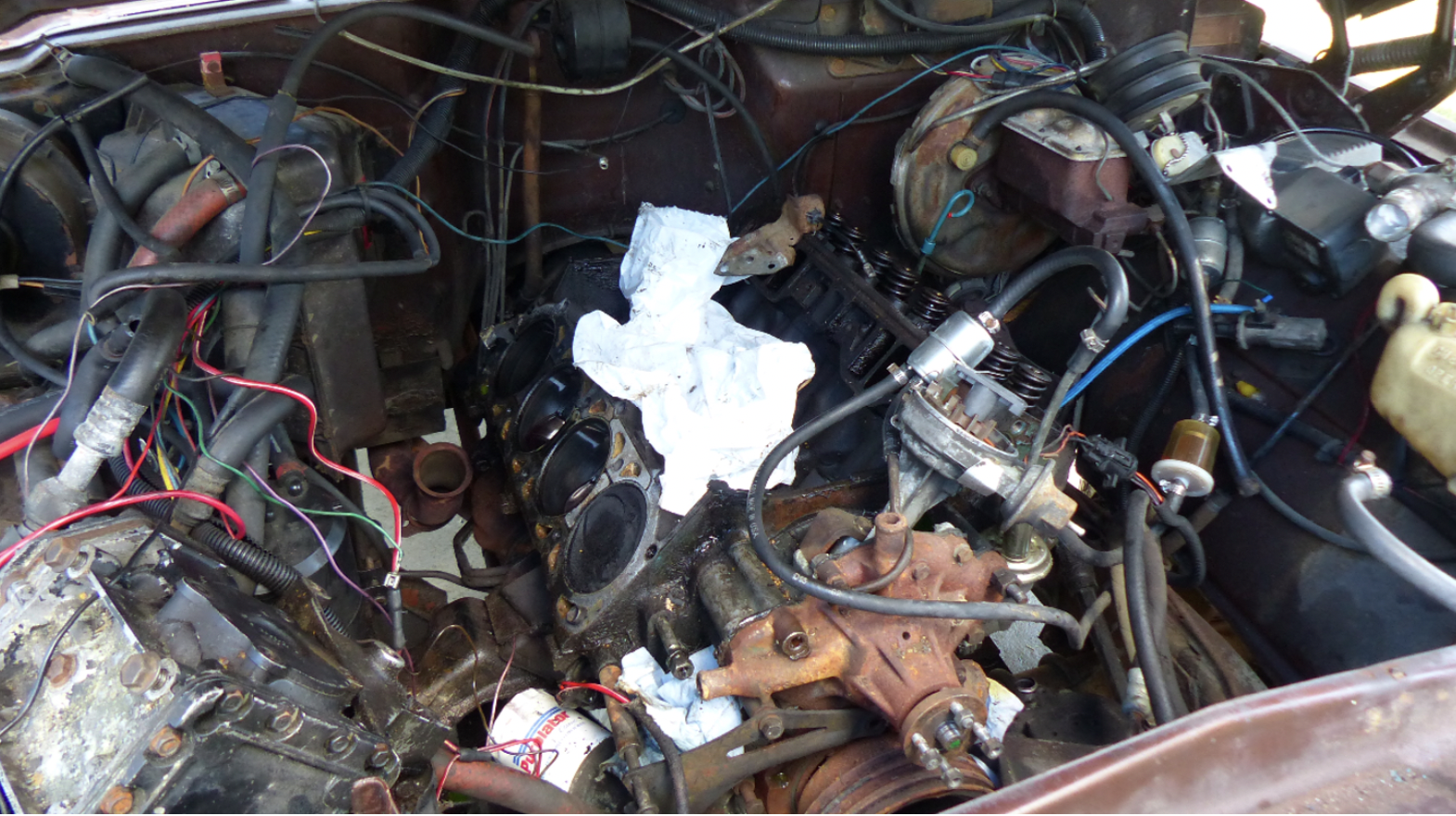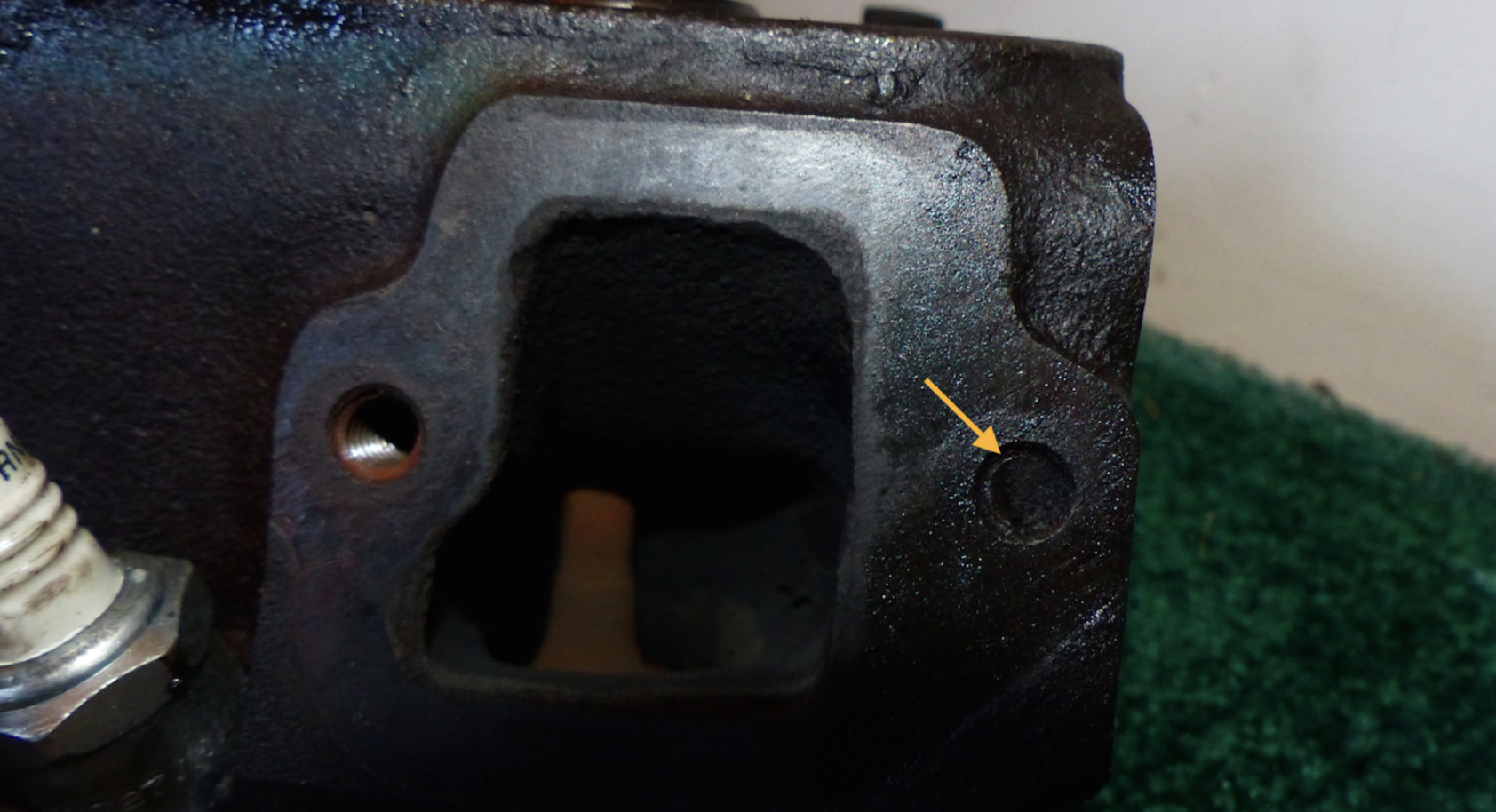How did this even happen? I bought my 1979 Jeep Cherokee Golden Eagle five years ago. The vehicle actually ran and drove just fine, aside from its propensity to stall under load, though this was probably just an ignition timing issue. Just listen to this thing idle!:
Shared post on Time Honestly, an hour of basic tinkering, and that thing should have been humming down Woodward Avenue, sucking down gas like semi truck. But that’s not what happened.
I noticed that there was an exhaust bolt broken in the cylinder head, and — keen to fix the resulting exhaust leak — I decided to remove the engine’s passenger’s-side cylinder head. I took it to a shop, who extracted the broken bolt, and then I should have reinstall the head and driven off into the sunset. Instead I flew to Germany for a month to hang out with my family; during that time, the saran wrap I’d placed over my exposed cylinders blew away, and by the time I returned from Germany, the cylinders were rusted.
I should have just run the engine anyway. That light surface rust was probably not a big deal. Maybe it’d have been smart to vacuum out any dirt particles that may have made it into the cylinders, but other than that, I should have run that AMC 360 and enjoyed the beautiful Jeep’s comfortable ride and burbly exhaust note. But I didn’t do that. Instead I chose to remove the whole damn engine so I could hone the rust off the cylinder walls. “You know what, the ridge on the cylinder walls doesn’t look good anyway,” so let me just take this whole motor apart and replace bearings/rings. Then, for some reason, I couldn’t get the pistons to go back into the cylinders without locking up the motor.
I checked ring end-gaps and even used the old rings: The motor just wouldn’t go back together. To this day, I’m baffled by the whole thing, and while I know my friends and I would have solved this eventually (how can you not just put a motor back together the way it was before? Come on, DT, that’s not rocket science), the fact is that the city of Troy was on my ass. So I had to act fast. I bought a freshly-rebuilt AMC 360 from a friend of a friend. It was complete aside from the high-flow oil pump he took off for his other engine.
In installed a new oil pump, threw the motor in, and fired it up. Things seemed fine at first; the engine sounded good. I turned the Jeep towards Woodward Avenue and had a wonderful cruise to my favorite diner, Hunter House. Then I began hearing top-end knocking.
Shared post on Time I drove home, removed the valve covers, and noticed that there was no oil flowing to the top of the engine. Bizarre. I threaded a mechanical gauge into my oil filter adaptor: 40psi (see below) while warm; not bad! Why the hell wasn’t I getting oil to the top of my motor, then?
Well, folks, it appears I have figured that out. After neglecting the problematic motor for so long, I just began wrenching on it again this past weekend, and what did I discover? It’s seized. I don’t think it’s the rings, either. I think there’s something wrong with the camshaft bearings. I think somehow there’s a blockage in the cam bearings’ oil passages that would normally feed the lifters and the top of the motor. The bearing could be locking the camshaft in place, and since the camshaft and crankshaft are connected via the timing chain, I’m unable to move the crankshaft by hand; this thing really is stuck.
A post shared by David Tracy (@davidntracy)
If I had to guess, my foolishness in not priming my new oil pump led to an oil starvation issue during my initial start, causing the camshaft to eat one of its bearings, starving the top of the motor of oil, leading to top-end knocking.
Anyway, this is bad news. I now have to remove the new engine from the Jeep, and see what I’ll have to do to save it.
In any case, I’ve now basically destroyed two engines, all without driving the Jeep more than a few miles up and down Woodward Avenue. I’m ashamed of this, because it’s a product of my own poor decision making. I shouldn’t have left the engine so poorly protected while I was traveling, I shouldn’t have remove the engine due to minor surface rust, I shouldn’t have torn the whole thing down, I shouldn’t have thrown a new oil pump into my refreshed engine without checking its clearances, I shouldn’t have run that motor without first priming the pump so that the important engine components receive lubrication at the first engine start-up in a while.
I have been a terrible owner for this Jeep; I’ve got too much shit going on all the time, between travel and city ordinances and writing and wrenching on other things. Focusing my thoughts in 100 different directions has led me to make decisions that caused this Jeep to languish in my driveway for five years. The Jeep gods will never forgive me, so I will have to prepare myself to live in Jeep Hell with the two-wheel drive Compasses and Patriots. I brought it upon myself.
One of my personal cars, a 1988 Mitsubishi Starion ESI-R, I managed to develop a very very faint rod knock. No problem, done this before on other cars, we’ll just drop the pan, and swap out the rod bearings, and be on our merry way.
Got it done, went for a very calm test drive, watched oil pressure, and engine temp, all looked good. 6 miles later, here comes the knock back. Well, son of a bitch, must have done something wrong….maybe a little piece of grit somewhere, who knows. Gently back home.
Do it again! Make sure everything was spotless, every cap in the right place and orientation, assembly lube in place, perfect torque, you get the idea.
Six miles later, still quiet!
18 miles later, it’s beginning to feel a bit soft on power. Look down, it’s running a touch warm. Look over at the turbo boost gauge, and to keep the car running at 40 MPH, I’m using 12 PSI turbo boost. Soon enough, I’m on the floor to keep it running at the speed limit.
Hoping and praying I make it home!
Get to the house, lift off the throttle, and I get that noise……”SQUEEEEEEEAL!”
“Oh…….shit.”
Hit the key, and man, it was just that click of finality. Looked under the hood, the coolant in the reservoir was boiling, and the exhaust from the hot side of the turbo all the way under the car was just cherry red.
So, shit happens, even to the best of us. Look at this way. If the really kickass engine guys were perfect, they wouldn’t grenade engines at Nascar races, LOL.
The thing was, he had a crate motor that time. He had been burned so many times by his own rebuilds that he couldn’t imagine NOT having teething issues when he started it up the first time.
I never got that until I rebuilt my first motor alone. Ford 300 I6, timing gears instead of a chain, the gears have two cast-in dots to show the timing position. I remember lining them up, but I must have pulled the crank or cam to do something, then put it back in haphazardly. Took me 6 weeks of trying damned near everything to figure it out. In that 6 weeks I washed the #5 cylinder enough that the oil rings didn’t seat. Engine runs, but its almost a two stroke now, just without the power associated with a two stroke. It sucked.
So about that 5 speed Manuel 240 for close to LeMons money…where is it and how much we talkin here?
OOOOOOOOOR….this is the one to electrify. The Golden E-gle. Just make sure if you do screw that up, your profile pic clearly shows the smoking tips of your hair….
….no wait, does rust conduct electricity?
On a completely unrelated note, totally, I swear, does anybody want a running-but-not-driving-without-tires five-speed Volvo 240 wagon for close to LeMons money?
…although the brake bleeder that snapped off can go to Hell and stay there.
(We all know #1 is Deep Beryl Green PGV and #2 is Gunmetal Blue Pearlcoat PC6. And #4 is obviously Nitro Yellow Green PF2.)
Oh, and I’ll tell David you promised to help him fix all his cars.



